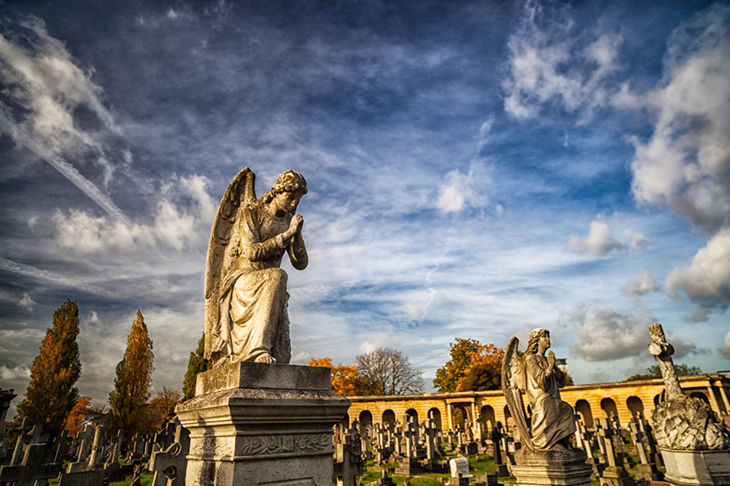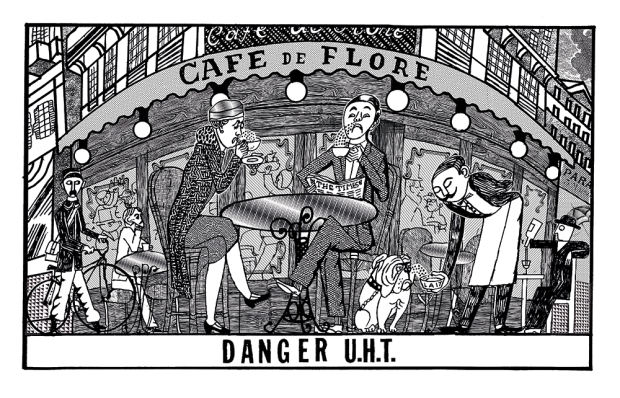It is cold, dank and muddy and I’m contemplating a barely defined path from the paved road into an ever-darkening wood. I should have brought a torch, but I didn’t, and before the light fades completely I need to find the ‘idyllic’ woodland burial ground I have shortlisted as a possible resting place for my late husband’s ashes; and also, when the time comes, for my own.
When I get there, the site is glorious: on a slope, on the edge of a real forest — the sort of place the woodland-obsessed Germans probably have a special word for. The colours are sombre in the evening light and flights of birds wheel overhead. It’s the closest thing I’ve found to a place that feels right, but then, what is the right place to be buried when you’re a citizen of nowhere?
As a family, we had it easy with my parents. They retired to a classic English village. They were churchgoers — my mother took her turn on the flower rota, my father became a lay reader — and they are buried in the churchyard, like generations before them. The gravestone, shockingly white when it was put up after my father’s death, and later inscribed with my mother’s name too, is now weathered grey like all the rest.
But it is less easy for the growing numbers of us who have lived peripatetic lives or who do not go to church or profess a religion. The funeral sector is finally changing in response to new demands: in the matter of funerals and burials, the UK has one of the most permissive regimes in the developed world. But how to make a decision? For years the ritual around death was inherited and unchanging. Now almost anything goes.
David Bowie is credited with setting a trend for ‘direct cremation’, which produces the ashes without ceremony, allowing for a more personal commemoration afterwards, or nothing. What is more, you can scatter ashes pretty much where you like — including, for Liverpudlians, from Mersey ferries.
My own starting points were my late husband’s delight in what he saw as the quintessential Englishness of the Chilterns, his fondness for the forests of the US state of Maine where he grew up, plus his misgivings about organised religion. In the quest for a place that felt right, I drove many miles along the B roads of deepest Oxfordshire and Buckinghamshire, cursing tractors, ill-placed signposts and stray sheep. I crossed London many times from the ordered west to the wild east, dodging delivery vans and cyclists and idling Ubers along the way. I considered pretty much everything.
I remember well two of the wilder burial grounds, both vast tracts of land, with long, bleak winter views. One was entered through an almost unmarked farm gate and had a wood on the slightly elevated horizon. You could call someone to be shown around, or be left to yourself. I padded down the track towards the wood, but turned back. Too far, too anonymous, too… it was hard to identify quite why, but I returned to my car, satisfied to have eliminated what had looked like a promising possibility.
The second, outside Oxford, was a similarly open site, with views of fields forever. (Where is this overcrowded England some talk of?) But it had little gradient and few trees, and the wildness was being tamed. There was a big car park and a round hall with glass walls. A crematorium was under construction. Entrepreneurship has come to the burial business, and why not?
Even so, it was the plethora of dangling, jangling new-age symbols that put me off. My husband might have (partly) rejected the icons and incense of his childhood, but he had never given any sign of wanting to swap them for another belief system. Clearly, the owners of this enterprise knew their market — it just didn’t include me. In ‘wild’ and ‘alternative’, I had reached my limits.
So I reversed track, in every sense, and spent a couple of afternoons at the City of London cemetery. If you live in or near London and can spare half a day — and perhaps eternity — you should go: this is the burial business supercharged for the 21st century.
It is a vast walled territory between the edge of London and Epping Forest that you may well have driven past unawares. When you find it, you ask how something so huge could also be so invisible. Inside the main gate, the visitor centre is a highly professional operation. There are smartly presented assistants, glossy catalogues with prices, and samples of urns and caskets. The cemetery is so big that prospective customers are trundled around in a minibus. Different sections are defined by their landscaping.
You can have pretty much anything at City of London: from mini-mausoleum to a niche in a commemorative wall; from a plaque in a formal garden of remembrance to an unmarked woodland plot. You can ask for the shade of a particular tree. Were some trees in more demand than others, I asked, confiding that I had in mind a pine. Most people, I was told, wanted flowering trees or shrubs away from the road. A pine by the path was no problem.
It was getting dark and raining, and my assigned helper suggested that I might come back in the spring to see it all in a better light. To me, it actually looked as good as a vast cemetery could look on a winter’s day. I was tempted, until I returned a week later to find the entrance resembling a stage set, with an elaborate white carriage, half a dozen plumed horses and a whole entourage drawn up outside the gate. Just not my scene.
So it was back to the internet, and another look at London cemeteries, although few of the more central graveyards are open any longer for new burials. Brompton, on the edge of Chelsea and Earl’s Court, is an exception in two ways: in being designated a Royal Park and in still, when I enquired, having space for ‘ashes burials’. Indeed, they seemed slightly upset that they were not approached more often; they were considering advertising their services.
Brompton Cemetery is a strange wilderness, uncannily quiet but for the calling of crows. Its monuments are a cultural, ethnic and architectural mélange. From the west, high-rises cast their shadow, and Chelsea fans use the main thoroughfare as a short cut on match days. I’m not sure what my husband would have made of that, but he would have appreciated, I think, the fact that it’s simultaneously cosmopolitan and airy.
And yet… I recently returned fleetingly to Palermo, where my husband died. The sun shone, the sky was blue and the water was a deep, deep turquoise, just as it had been then. Looking out over the bay, I half-wished that I’d simply scattered his ashes on the Tyrrhenian Sea beside the gleaming white rock of Monte Pellegrino.
Got something to add? Join the discussion and comment below.
Get 10 issues for just $10
Subscribe to The Spectator Australia today for the next 10 magazine issues, plus full online access, for just $10.
You might disagree with half of it, but you’ll enjoy reading all of it. Try your first month for free, then just $2 a week for the remainder of your first year.














Comments
Don't miss out
Join the conversation with other Spectator Australia readers. Subscribe to leave a comment.
SUBSCRIBEAlready a subscriber? Log in